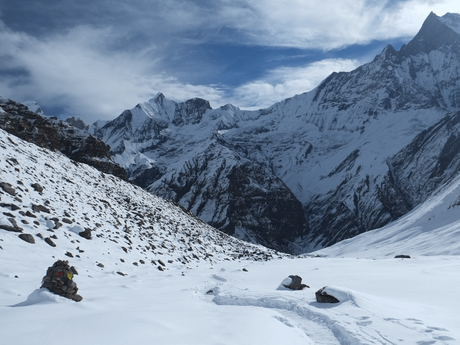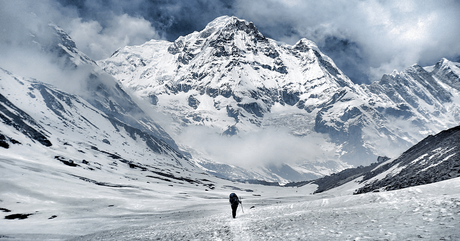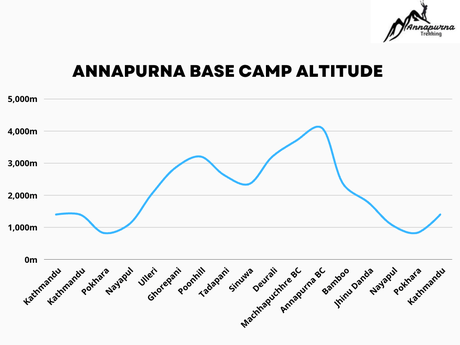Are you planning on a journey to the world’s rooftop, where the mighty Himalayas stand majestically and the uncharted wilderness calls out to be explored? As you trek towards the Annapurna Base Camp, a new world awaits you – awe-inspiring natural beauty and unparalleled adventure. But be warned, for at these high altitudes, the thin air holds a danger that is all too real – the threat of altitude sickness. With proper preparation and understanding of this condition, however, you can conquer the mountain and make memories that will last a lifetime.

Altitude Sickness and Annapurna Base Camp
At high altitudes, the body sometimes has trouble adjusting to less oxygen which can cause symptoms like headaches, feeling sick, dizziness, and breathing problems. Usually, people can climb to moderate heights without issues, but people with a higher chance of getting AMS, like people with heart or lung issues, may have more risk of getting it.
The Annapurna Base Camp trek, a renowned haven for hikers and trekkers, draws thousands of enthusiasts annually with its panoramic vistas of the Annapurna mountain range and its surrounding panoramas. Despite its undeniable charm, the altitude of the base camp necessitates that trekkers be prepared for the risk of altitude sickness. Proper acclimatization and preventive measures are crucial for preventing AMS, as the condition can prove difficult if ignored. Hiking enthusiasts can implement various tactics to reduce the likelihood of acquiring altitude sickness. One of the most productive strategies is increasing elevation step-by-step, providing sufficient body time to acclimate to the reduced oxygen concentration. Additionally, maintaining proper hydration levels is essential, as dehydration can boost the effects of Acute Mountain Sickness (AMS). Other preventative measures include abstaining from alcohol and tobacco, obtaining ample rest, and consuming a carbohydrate diet.
You may also Like:
- Annapurna Circuit Complete Guide
- Nar Phu Valley trek
- Mardi Himal Trek: Comprehensive Guide
- Tilicho Lake trek Complete Guide
Insights of Annapurna Base Camp

Annapurna Base Camp is one of the most famous trekking destinations in the world. The base camp is at an altitude of 4,130 meters above sea level and 40 km north of the beautiful city of Pokhara.
Like many other trekking destinations in Nepal, Annapurna Base Camp is also a gateway to view the scenic beauty of many peaks like Annapurna, Dhaulagiri, Fishtail mountain, Hiunchuli, and others.
Natural well-being is always the topmost liked aspect of the base camp. It includes the mountain ranges, the beauty of the Annapurna Conservation area, and other places like Ghorepani and Poon Hill.
Besides the natural richness, people and their history & culture are the attractive pieces of this area that brings thousands and thousands of national and international tourists annually. The place is rich in Gurung and Magar culture, especially the Ghorepani and Poon Hill villages. Similarly, the hospitality the tourist gets from the locals is admirable, and no culture comes near to it worldwide.
If you think of trekking to Annapurna Base Camp (Sanctuary), it will always be calm. It might be physically challenging, but this area’s beauty and welcome are enough to reduce the stress of any challenge.
Elevation of Annapurna Base Camp
Annapurna Base Camp is a high-altitude trek at 4,130 meters, 13,550 feet. The hike features a significant elevation gain from Tikhedunga (1480 meters) to the top of the base camp (4130 meters).
The elevation of Annapurna Base Camp is challenging to many trekkers, while it is considered easy to moderate for the experienced ones. If you are not okay with the rise in altitude and your body is not flexible with high altitudes and its environment, you will probably be in a problem. It might come as altitude sickness or any other form of illness. So prepare yourself before going on the Annapurna Base Camp trek is highly recommended.
Altitude Sickness At differrent altitude in Annapurna Base Camp
Altitude Sickness is no strange name for a high-altitude climbing journey. Since Annapurna Base Camp also lies at a high altitude, no one knows if your body can adjust to that environment. That’s why we recommend proper preparations.
You need not worry about any altitude-related issues in your journey from the picturesque Nayapul, where the elevation is a mere 1070 meters.
However, you may feel slight discomfort due to the altitude as you make your way up to the panoramic Ghorepani, standing at a striking 2874 meters, and the breathtaking Poonhill, towering at 3200 meters. But be at ease, as the height of these elevations poses no threat of altitude sickness. Likewise, the elevation of Chhomrong at 2160 meters and Dobhan at 2500 meters also pose no threat of altitude illness.

As you reach the apex of Deurali, located at an altitude of 3230 meters, the trekkers need to remain alert for any symptoms of altitude sickness. This height demands extra caution and care. The beginning of Acute Mountain Sickness (AMS) is common at an elevation of approximately 2,400 meters, or 8,000 feet. Nevertheless, the danger of developing AMS soon escalates as one ascends to greater heights.
Altitude sickness might come in various forms: Acute Altitude Sickness, High Altitude Pulmonary Edema (HAPE), and High Altitude Cerebral Edema (HACE).
Acute Altitude Sickness generally features the symptoms like dizziness, insomnia, nausea, and vomiting. HAPE impacts your lungs, making breathing hard to breathe and decreasing heartbeats. In the same way, HACE is regarded as the most dangerous type of altitude sickness, which affects your cognitive ability as it forms fluid in the brain system.
Keeping these things in mind, you should plan your trekking schedule and safety measures accordingly. And it will be helpful for you to conquer the Annapurna Base Camp trekking.
How To Get Rid Of Altitude Sickness During Your Annapurna Base Camp Trek?
Annapurna Base Camp might be easy for some, but it can be challenging for unprepared trekkers. A backup plan is essential before starting your voyage so that you will experience fun and adventure throughout the trekking.
Here are some of the ways you can mitigate catching Altitude Sickness in Annapurna Base Camp:
Choose Favorable Seasons
You have to choose the favorable seasons to hike around the Annapurna region. Off-season treks might be negatively impactful though they might be cheaper than the regular ones financially.
There are two seasons for this trekking: Pre-Monsoon Trekking and Post-Monsoon Trekking. The pre-monsoon season for trekking at Annapurna Base Camp is around February, March, April, and May. Similarly, September, October, November, and December are considered the post-monsoon seasons.
But remember this, winter in Annapurna Base Camp is always harsh. So be prepared for the worst if you are about to take off during the winter.
Be Physically And Mentally Prepared
Both your physical and mental abilities should be top-notch if you are about to start this trek. Being in the excellent physical form helps you to trek better and mitigates the physical issues during the trip. Similarly, being mentally strong and willing to conquer the trek with a proper plan will surely take you to the highest point of Annapurna Base Camp.
You should remember that Annapurna Base Camp Trek needs a high level of strength, so if you feel like you cannot continue as your body says no, you should stop and descend to the lower altitudes.
Safety And Gears
Being safe is essential, and preparing to be safe throughout the trek will be a wise idea. Several factors, like your trekking gear, adversely impact your tour success.
It will be easy if you are out on a trek with good and essential gear and wearables. Similarly, other safety materials like oxygens, pain relievers, and more will be helpful without any doubt.
Follow The Instructions of the Guide
Safety Instructions are essential during trekking. Especially if you are not a regular trekker, you will need a set piece of guidelines and an eye to watch over throughout the trek.
Follow what your guide says, and don’t do anything unnecessary to harm your health and body. Please exclude the intake of alcoholic and caffeine products.
Stay Hydrated And Full
If you start your trek on an empty stomach, it leads to a problem. Being energized and hydrated will make your hike easier than not being. So take your regular meal and drink plenty of water to remain healthy. Also, skip heavy meals but rely on highly nutritious snacks.
Annapurna Base Camp is one of the all-time favorite destinations of tourists that come to Nepal. Despite many of them being prone to altitude sickness, the base camp never fails to astonish you with its beauty. But as we have talked much about it, Annapurna Base Camp will be easier to conquer with a proper plan, backups, and physical fitness and guidance.
FAQ‘s
Has Anyone Died In Annapurna Base Camp?
Annapurna region faced a giant snowstorm disaster in 2014 that took the lives of 43 people. Although it was not due to altitude sickness, it shows that natural calamities are too vital factors that you should consider before starting your trip.
How Difficult Is Annapurna Base Camp?
Scholars consider Annapurna Base Camp (Annapurna Sanctuary) a moderate trek. Though some parts of the route are rugged and challenging, it is moderate overall.
What Can You View from Annapurna Base Camp?
Sightseeing is the main attraction of Annapurna Base Camp. Scenes of majestic mountains like Annapurna I, II, & III, Fishtail, Hiunchuli, Dhaulagiri, and others are visible from the base camp.
Is hiring a guide or porter compulsory for the trek?
As the path is marked and straightforward to navigate, hiring a guide or porter is not compulsory at all for trekkers. However, hiring a porter or guide has its benefits. One benefit is that a guide can furnish enlightening information about the local culture, flora, and fauna and facilitate communication, as many individuals in the area need to speak English fluently.
Can beginners choose Annapurna Base Camp to trek?
The answer is a resounding yes! Since the trek route is moderately challenging, it is well-suited for beginners and experienced ones.
